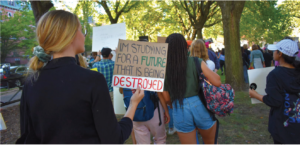
High-school and college students gathered in Hartford and New Haven to demand climate-change reforms. Photo courtesy of Charissa Lin
Inspired by the work of 16-year-old Swedish climate activist Greta Thunberg, more than four million people, most of them high school- and college-aged, assembled in 163 countries across the globe last Friday, September 20, to protest the lack of progress in fighting climate change.
In Connecticut, more than 1000 protesters joined a climate strike at the State Capitol, in Hartford, and more than 600 protesters participated in a strike in New Haven. Students from high schools and colleges across the state, including between 40 and 50 students from Choate, and political figures such as Senator Richard Blumenthal and State Representatives Gregg Haddad and Christine Palm gathered at these demonstrations to pressure the Connecticut state government into taking more aggressive action to combat climate change.
During the three-hour-long strike, speakers from various organizations delivered speeches about climate-change topics, ranging from the stories of climate refugees to the damaging effects of burning fossil fuels. Between speeches, protesters shouted rhyming chants and participated in group activities, such as chi gong, a Chinese mindfulness exercise, to boost the energy of the crowd.
Protesters also took part in a “die-in” demonstration in which the crowd laid on the ground to represent the looming possibility of humanity’s extinction due to climate change. The protesters remained on the ground for 11 minutes, to symbolize the 11 years most scientists believe humanity has to prevent the earth’s temperature from rising to irreversible levels. The die-in was followed by two minutes of reflection, complemented by peaceful bell sounds playing in the background. “I could not help but hold hands with the people next to me, just to reassure and support each other,” said Sunny Sun ’20, one of the Choate students who attended the Hartford strike.
The event concluded at around 3:00 p.m., on the steps of the Capitol, where the leaders of the protest, Sena Wazer, a freshman at the University of Connecticut, and Mitchel Kveder, a sophomore at Eastern Connecticut State University, presented a formal resolution addressed to Governor Ned Lamont.
The resolution demanded that the state government declare an official climate emergency and enact emergency legislation to confront the climate crisis. It also called for the elimination of all pollution that contributes to climate change in Connecticut by 2030 and for the government to stop approving permits which allow corporations to build fossil-fuel-related infrastructure. “This will force [the governor] to really say, ‘Yes, we are in a state of emergency, and we need to take this seriously,’ which is something that politicians don’t do a lot of the time,” said Wazer.
In New Haven, the New Haven Climate Movement (NHCM), an organization that advocates for New Haven to transition to 100% renewable energy, organized a rally that began at 4:00 p.m at the corner of Church and Chapel Streets. Participants were encouraged to wear black and carry cardboard tombstones to mourn the accelerating death of the planet. Across the New Haven Green, speakers discussed the major causes of climate change, including the burning of fossil fuels, deforestation, and livestock farming.
The NHCM also used the rally to gather support for their Safe Climate Emergency Resolution, which has yet to be signed by New Haven Mayor Toni Harp. The resolution calls for the establishment of a climate emergency task force, government support for environmental advocacy groups in New Haven, and the allocation of funds in New Haven’s budget toward the reduction of greenhouse-gas emissions.
At the end of the rally, as the protesters left the Green and marched toward City Hall, the number of protestors grew so large that the police had to block off streets to ensure the safety of the participants. “When we blocked off the street, I realized how much support we had gotten, how big this rally was, and how many people cared about it,” said Catalina Homann, a NHCM youth organizer and a junior at Wilbur Cross High School.
On the steps leading up to City Hall, posters marked “greed,” “denial,” and “silence” were placed into a coffin to illustrate the actions that need to “die” in order to successfully combat climate change.
The New Haven rally also participated in a two-minute die-in, to symbolize the NHMC resolution’s demand that the New Haven government begin to reduce greenhouse-gas emissions within the next two years. The protesters rose and sang “More Waters Rising,” by Saro Lynch-Thomason, which catalogues the effects of climate change.
At the end of the rally Adrian Huq, another NHMC youth organizer and a senior at the Metropolitan Business Academy in New Haven, called on the crowd to take immediate action to fight climate change. “We need to commit to fight for a safe future,” Huq said. “It is a necessity to have a livable climate for generations to come, and everyone deserves a safe place to live.”




